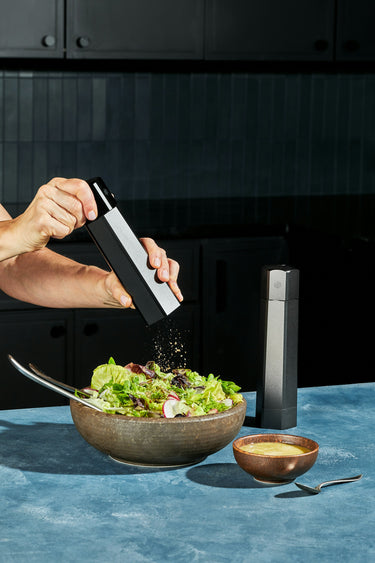5 Tools That Make Cooking So Much Easier

When you think of cooking, what is it you picture? Cracking a fresh egg into gently foaming butter in a little skillet? Or perhaps settling a gorgeous rack of lamb into your roasting pan? Cooking means many things, but it isn’t just about what’s happening in your pots and pans. (That being said, having a great set of pans certainly makes a difference.) Though it may not be as sexy as searing a steak in your pan or as nostalgic as cooking up a batch of Sunday sauce in your favorite pot, using a few key tools can make your time in the kitchen safer and more efficient.
Case in point: Not having anywhere to put a hot pan is more than just inconvenient—it can potentially damage your countertop or table. Less-than-sharp knives don’t just make cooking more difficult, they’re actually dangerous. Pouring salt directly from the container can result in an over-the-top salty pasta. You get the point. A few key tools are all you need to up your cooking game. We’re not talking about expensive gadgets or silly single-use products that will gather dust in the back of your cabinet.
Here are the 5 unexpected tools that make cooking so much easier:
Trivet
Though they may feel old-fashioned, trivets are essential for protecting your kitchen surfaces. These flat, heat-resistant objects can come in many different materials. You’re likely to find a trivet in everything from cast iron to metal to ceramic to stone, but HexClad’s own trivet is made from flexible, easy-to-clean silicone. Cork is an increasingly popular trivet material, and felt offers a soft, low-profile option for hot pots. For the most efficiency, place a trivet next to your oven or stovetop so you can easily transfer the hot pot or pan straight to the trivet.
A heat-resistant oven mitt
Let’s start by clarifying that the most important tool in a kitchen is your hands, so it should follow that a tool that protects your hands is the best investment of all. An oven mitt enables you to easily move things to and from the oven, natch, but not all oven mitts are created equal. Look for one that has heat-resistant, anti-slip material like silicone, which can protect you from transferred heat or from dropping hot pots. HexClad’s oven mitt combines this with a soft, cotton interior.
A sturdy cutting board
Crucial for kitchen safety, a sturdy cutting board is less likely to slip around on the countertop as you work. Plus, a thicker cutting board—look for one that’s around 2-inches thick—is less likely to warp and will stay in place better during use. A knife is only so good as the surface it cuts on, which means that a cutting board is more than just a good investment—it’s essential. Wood cutting boards can stand up to years of cutting, contain antimicrobial properties, and do minimal damage to a knife’s edge. A flat, wooden cutting board that has no feet is best for your regular chopping and slicing needs because you can flip it over to use both sides.
Pro-tip: Cut out a square of anti-slip drawer liner that’s the same size as your cutting board. Place this down beneath the cutting board so it doesn’t move around while chopping.
Honing Steel
Though a honing steel (often called a honing rod or sharpening steel) doesn’t actually sharpen the blade, it is a useful tool to involve in your daily kitchen routine. Honing realigns the microscopic pieces of the blade that get bent out of line by cutting, which means your knives stay sharp longer. Hold the knife at a 15-degree angle to the steel and gently stroke the blade from the rod’s handle downwards. If your knife is truly dull, take your knives to be sharpened professionally or use a whetstone to sharpen it yourself.
Salt and pepper grinders
Though salt and pepper are as common as can be, these two seasoning all-stars can all-too-often be an afterthought in the kitchen. If you’ve ever tried to add a pinch and ended up adding a tablespoon, then you’ll know that controlling how much salt or pepper you use is as important to good cooking as anything else. Salt grinders do best with coarse salt, so don’t add fine sea salt or kosher salt to your grinder. As for pepper, we won’t even pretend you’re using the pre-ground stuff (but if you are, please throw it out). A great pepper grinder does more than just pulverize the dried berries for easy distribution—the burr grinder mechanism gently crushes the pepper and in doing so, releases the complex aromas contained within. As for peppercorn varieties, go for what you like best: black Tellicherry are most common, but the white, green, and red varieties are all worth the grinder’s salt.





